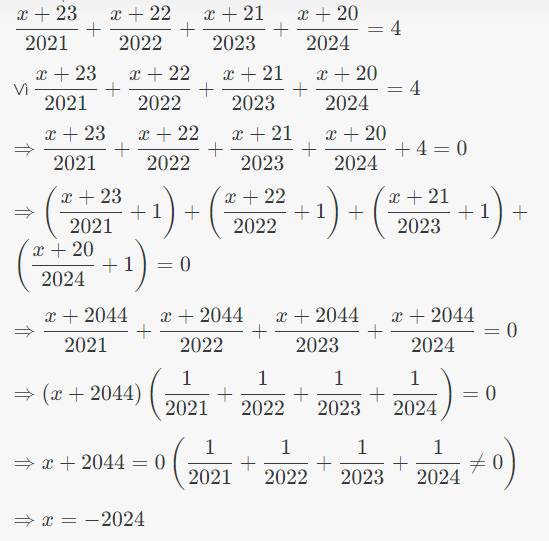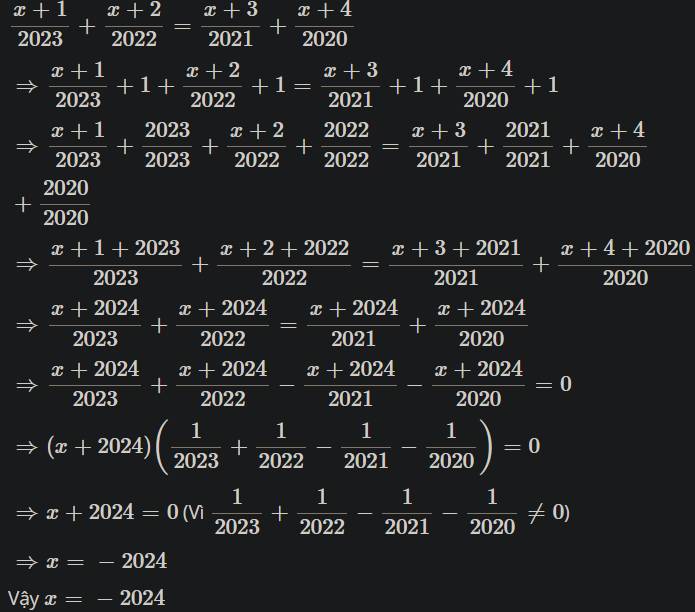x+4/2021+x+3/2022=x+2/2023+x+1/2024

Những câu hỏi liên quan
\(P\left(x\right)\)=\(x^{2023}-2024.x^{2022}+2024.x^{2021}-2024.x^{2020}+.....+2024.x-1\)
tính P ( 2023)
Giải nhanh giúp mik ạ !! đang cânf gấp O(∩_∩)O
Với x = 2023
<=> x + 1 = 2024
Khi đó P(2023) = x2023 - (x + 1).x2022 + ... + (x + 1).x - 1
= x2023 - x2023 - x2022 + .. + x2 + x - 1
= x - 1 = 2023 - 1 = 2022
Đúng 1
Bình luận (0)
Câu 6. Giá trị nhỏ nhất của biểu thức A = (x – y)2 + (x – 1)2 + (y + 2)2 + 2021 là
A. 2021 B. 2022 C. 2023 D. 2024
Dẫu '' = '' xảy ra khi và chỉ khi ( x - y )2 + (x – 1)2 + (y + 2)2 = 0
Đúng 1
Bình luận (0)
Xem thêm câu trả lời
\(\dfrac{x+23}{2021}+\)\(\dfrac{x+22}{2022}\)\(+\dfrac{x+21}{2023}\)\(+\dfrac{x+20}{2024}\)\(=\)mấy ?
Xem chi tiết
\(\dfrac{x+23}{2021}+\dfrac{x+22}{2022}+\dfrac{x+21}{2023}+\dfrac{x+20}{2024}=-4\)
Vì \(\dfrac{x+23}{2021}+\dfrac{x+22}{2022}+\dfrac{x+21}{2023}+\dfrac{x+20}{2024}=-4\)
\(\Rightarrow\dfrac{x+23}{2021}+\dfrac{x+22}{2022}+\dfrac{x+21}{2023}+\dfrac{x+20}{2024}+4=0\)
\(\Rightarrow\left(\dfrac{x+23}{2021}+1\right)+\left(\dfrac{x+22}{2022}+1\right)+\left(\dfrac{x+21}{2023}+1\right)+\left(\dfrac{x+20}{2024}+1\right)=0\)
\(\Rightarrow\dfrac{x+2044}{2021}+\dfrac{x+2044}{2022}+\dfrac{x+2044}{2023}+\dfrac{x+2044}{2024}=0\)
\(\Rightarrow\left(x+2044\right)\left(\dfrac{1}{2021}+\dfrac{1}{2022}+\dfrac{1}{2023}+\dfrac{1}{2024}\right)=0\)
\(\Rightarrow x+2044=0\left(\dfrac{1}{2021}+\dfrac{1}{2022}+\dfrac{1}{2023}+\dfrac{1}{2024}\ne0\right)\)
\(\Rightarrow x=-2024\)
Đúng 1
Bình luận (2)
tính nhanh
(2022 x 2023 + 2024 x 21 + 2002 ) :( 2024 x 2023 - 2022 x 2023 )
Cho em xin hỏi bài toán này ạ! Em xin cảm ơn !
1/2021×2022+1/2022×2023+1/2023×2024+1/2024×2025-4/2021×2025=
A = \(\dfrac{1}{2021.2022}\) + \(\dfrac{1}{2022.2023}\) + \(\dfrac{1}{2023.2024}\) + \(\dfrac{1}{2024.2025}\) - \(\dfrac{4}{2021.2025}\)
A = \(\dfrac{1}{2021}\) - \(\dfrac{1}{2022}\) + \(\dfrac{1}{2022}\) - \(\dfrac{1}{2023}\) + \(\dfrac{1}{2023}\) - \(\dfrac{1}{2024}\) + \(\dfrac{1}{2024}\) - \(\dfrac{1}{2025}\) - \(\dfrac{1}{2021}\) + \(\dfrac{1}{2025}\)
A = (\(\dfrac{1}{2021}\) - \(\dfrac{1}{2021}\)) + (\(\dfrac{1}{2022}\) - \(\dfrac{1}{2022}\)) + (\(\dfrac{1}{2023}\) - \(\dfrac{1}{2023}\)) + (\(\dfrac{1}{2024}\) - \(\dfrac{1}{2024}\)) + (\(\dfrac{1}{2025}\) - \(\dfrac{1}{2025}\))
A = 0 + 0 +0 + 0+ ... + 0
A = 0
Đúng 0
Bình luận (0)
Tìm số nguyên dương x sao cho 5x +13 là bội của 2x+1
Tìm x biết (2x-18).(3x+12)=0
Tính S= 1-2-3+4+
5-6-7+8+...+2021-2022-2023+2024+2025
1. Giải:
Do \(5x+13B\in\left(2x+1\right)\Rightarrow5x+13⋮2x+1.\)
\(\Rightarrow2\left(5x+13\right)⋮2x+1\Rightarrow10x+26⋮2x+1.\)
\(\Rightarrow5\left(2x+1\right)+21⋮2x+1.\)
Do 5(2x+1)⋮2x+1⇒ Ta cần 21⋮2x+1.
⇒ 2x+1 ϵ B(21)=\(\left\{1;3;7;21\right\}.\)
Ta có bảng:
| 2x+1 | 1 | 3 | 7 | 21 |
| x | 0 | 1 | 3 | 10 |
| TM | TM | TM | TM |
Vậy xϵ\(\left\{0;1;3;10\right\}.\)
2. Giải:
Do (2x-18).(3x+12)=0.
⇒ 2x-18=0 hoặc 3x+12=0.
⇒ 2x =18 3x =-12.
⇒ x =9 x =-4.
Vậy xϵ\(\left\{-4;9\right\}.\)
3. S= 1-2-3+4+5-6-7+8+...+2021-2022-2023+2024+2025.
S= (1-2-3+4)+(5-6-7+8)+...+(2021-2022-2023+2024)+2025 Có 506 cặp.
S= 0 + 0 + ... + 0 + 2025.
⇒S= 2025.
Đúng 0
Bình luận (0)
tìm giá trị lớn nhất của P = \(\dfrac{|x-2022|-|x-2023|+|x-2024|+2022}{|x-2022|+|x-2023|+|x-2024|}\)
tìm x
(x+1)/2023 + (x+2)/2022=(x+3)/2021 + (x+4)/2020
\(\dfrac{x+1}{2023}+\dfrac{x+2}{2022}=\dfrac{x+3}{2021}+\dfrac{x+4}{2020}\\ \Leftrightarrow\dfrac{x+1}{2023}+1+\dfrac{x+2}{2022}+1=\dfrac{x+3}{2021}+1+\dfrac{x+4}{2020}+1\\ \Leftrightarrow\dfrac{x+1+2023}{2023}+\dfrac{x+2+2022}{2022}-\dfrac{x+3+2021}{2021}-\dfrac{x+4+2020}{2020}=0\\ \Leftrightarrow\left(x+2024\right)\times\left(\dfrac{1}{2023}+\dfrac{1}{2022}-\dfrac{1}{2021}-\dfrac{1}{2020}\right)=0\\ \Rightarrow x+2024=0:\left(\dfrac{1}{2023}+\dfrac{1}{2022}-\dfrac{1}{2021}-\dfrac{1}{2020}\right)\\ \Rightarrow x+2024=0\\ \Rightarrow x=-2024\)
Đúng 2
Bình luận (0)
`(x+1)/2023+(x+2)/2022=(x+3)/2021+(x+4)/2020`
`=>(x+1)/2023+1+(x+2)/2022+1=(x+3)/2021+1+(x+4)/2020+1`
`=>(x+2024)/2023+(x+2024)/2022=(x+2024)/2021+(x+2024)/2020`
`=>(x+2024)/2023+(x+2024)/2022-(x+2024)/2021-(x+2024)/2020=0`
`=>(x+2024).(1/2023+1/2022-1/2021-1/2020)=0`
Vì `1/2023+1/2022-1/2021-1/2020` `\ne` `0`
`=> x+2024=0`
`=>x=-2024`
Đúng 0
Bình luận (0)
S=1-3+5-7+9-11+....+2023-2025
S=1+2-3-4+5+6-7-8+....+2021+2022-2023-2024
a:
Sửa đề: \(S=1-3+5-7+...+2021-2023+2025\)
Từ 1 đến 2025 sẽ có:
\(\dfrac{2025-1}{2}+1=\dfrac{2024}{2}+1=1013\left(số\right)\)
Ta có: 1-3=5-7=...=2021-2023=-2
=>Sẽ có \(\dfrac{1013-1}{2}=\dfrac{1012}{2}=506\) cặp có tổng là -2 trong dãy số này
=>\(S=506\cdot\left(-2\right)+2025=2025-1012=1013\)
b: \(S=1+2-3-4+5+6-7-8+...+2021+2022-2023-2024\)
Từ 1 đến 2024 là: \(\dfrac{\left(2024-1\right)}{1}+1=2024\left(số\right)\)
Ta có: 1+2-3-4=5+6-7-8=...=2021+2022-2023-2024=-4
=>Sẽ có \(\dfrac{2024}{4}=506\) cặp có tổng là -4 trong dãy số này
=>\(S=506\cdot\left(-4\right)=-2024\)
Đúng 0
Bình luận (0)
so sánh a, A=154/155+155/156 và B=154+155/155+156 b,C=2021+2022+2023/2022+2023+2024 và D =2021/2022+2022/2023=2023/2024
Xem chi tiết
a: \(B=\dfrac{154}{155+156}+\dfrac{155}{155+156}\)
\(\dfrac{154}{155}>\dfrac{154}{155+156}\)
\(\dfrac{155}{156}>\dfrac{155}{155+156}\)
=>154/155+155/156>(154+155)/(155+156)
=>A>B
b: \(C=\dfrac{2021+2022+2023}{2022+2023+2024}=\dfrac{2021}{6069}+\dfrac{2022}{6069}+\dfrac{2023}{6069}\)
2021/2022>2021/6069
2022/2023>2022/2069
2023/2024>2023/6069
=>D>C
Đúng 2
Bình luận (0)
































